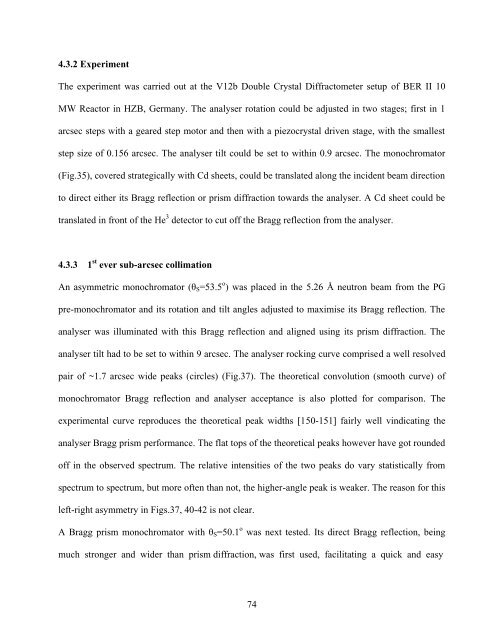PHYS01200804001 Sohrab Abbas - Homi Bhabha National Institute
PHYS01200804001 Sohrab Abbas - Homi Bhabha National Institute
PHYS01200804001 Sohrab Abbas - Homi Bhabha National Institute
You also want an ePaper? Increase the reach of your titles
YUMPU automatically turns print PDFs into web optimized ePapers that Google loves.
4.3.2 Experiment<br />
The experiment was carried out at the V12b Double Crystal Diffractometer setup of BER II 10<br />
MW Reactor in HZB, Germany. The analyser rotation could be adjusted in two stages; first in 1<br />
arcsec steps with a geared step motor and then with a piezocrystal driven stage, with the smallest<br />
step size of 0.156 arcsec. The analyser tilt could be set to within 0.9 arcsec. The monochromator<br />
(Fig.35), covered strategically with Cd sheets, could be translated along the incident beam direction<br />
to direct either its Bragg reflection or prism diffraction towards the analyser. A Cd sheet could be<br />
translated in front of the He 3 detector to cut off the Bragg reflection from the analyser.<br />
4.3.3 1 st ever sub-arcsec collimation<br />
An asymmetric monochromator (θ S =53.5 o ) was placed in the 5.26 Å neutron beam from the PG<br />
pre-monochromator and its rotation and tilt angles adjusted to maximise its Bragg reflection. The<br />
analyser was illuminated with this Bragg reflection and aligned using its prism diffraction. The<br />
analyser tilt had to be set to within 9 arcsec. The analyser rocking curve comprised a well resolved<br />
pair of ~1.7 arcsec wide peaks (circles) (Fig.37). The theoretical convolution (smooth curve) of<br />
monochromator Bragg reflection and analyser acceptance is also plotted for comparison. The<br />
experimental curve reproduces the theoretical peak widths [150-151] fairly well vindicating the<br />
analyser Bragg prism performance. The flat tops of the theoretical peaks however have got rounded<br />
off in the observed spectrum. The relative intensities of the two peaks do vary statistically from<br />
spectrum to spectrum, but more often than not, the higher-angle peak is weaker. The reason for this<br />
left-right asymmetry in Figs.37, 40-42 is not clear.<br />
A Bragg prism monochromator with θ S =50.1 o was next tested. Its direct Bragg reflection, being<br />
much stronger and wider than prism diffraction, was first used, facilitating a quick and easy<br />
74
















